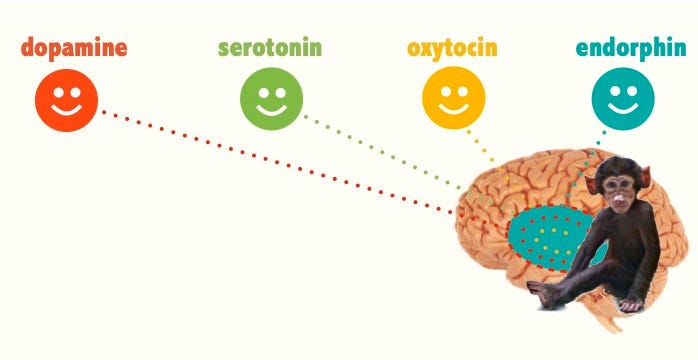You have power over your happy brain chemicals
That power is hard to find, however, because our happy chemicals are controlled by our non-verbal mammal brain. This newsletter explains your inner mammal so you can make peace with it. And it’s free!
You may know my work already from my books, podcasts, videos, and social media. This newsletter will not repeat what I have said elsewhere. I will use this platform to discuss controversial mental health topics that tend to be censored elsewhere. You may wonder what could be “problematic” about knowing your mammal brain. Read on!
Life would be simple if the brain made you feel good when you did good. But sometimes, you feel good when you do bad, and sometime you do good but don’t end up feeling good. What’s going on?
You will never figure it out if you stick to popular models of how the brain works. Our emotions are controlled by a limbic brain inherited from earlier mammals. It’s wired by early experience, despite our best intentions. It’s hard to understand what makes us feel good until we know what turns on the happy chemicals in animals. Then you can see what turned them on in your unique individual past, building the wiring that drives you today.
Monkey research in the late twentieth century showed us what turns on dopamine, serotonin, oxytocin, and endorphin. Each of these chemicals turns on a different good feeling, which motivates us to take action to meet a different survival need. This Substack does not introduce the chemicals because that is already available on the Inner Mammal Institute website, in my free 5-day Happy Chemical Jumpstart, and my book, Habits of a Happy Brain: Retrain your brain to boost your serotonin, dopamine, oxytocin and endorphin levels. There’s a free quick introduction in my videos: YouHavePowerOverYourBrain.com and in my course: ReWire Your Brain To Feel Good Now.
Academic psychology ignored this essential information. It presumes that animals are altruistic and ignores the way happy chemicals reward survival behavior. It blames distress on society and genes, skimming over the wiring built by early experience. We are told that happiness is the default state of nature that “normal” people get effortlessly. We are not told that the happy chemicals are only meant to turn on in short spurts, so ups and downs are inevitable.
Nevertheless, you have a choice. You can get real about your inner mammal with or without the approval of the therapy-industrial complex.
But it’s hard.
It’s hard to find the internal source of your emotions when others are focused on external triggers and virtue signaling.
It’s hard to take responsibility for your brain when the therapy-industrial complex offers to manage it for you.
It’s hard to rewire your brain because old wiring is efficient, so we flow there without consciously noticing a choice.
This newsletter shows how you benefit from accepting your inner mammal perspective. You find peace when you know what turns on your dopamine, serotonin, oxytocin, and endorphin naturally, and why they’re not meant to be on all the time. You will free yourself from distress when you know how to rewire old templates.
It’s not easy to manage this brain we’ve inherited. Fortunately, one small step sparks some dopamine, which makes the next step easier. When you know what makes your inner mammal happy, you can find healthy ways to step toward that.
I look forward to exploring our inner mammals together. Please share this with anyone it can help.


